WHAT'S NEW ACROSS THE WORLD
What's
new April 2000
What's
new July 2000
What's
new October 2000
| What's New ©by
Laif DeMason
Winter 2000-2001 has struck with a vengeance,
affecting many aspects of the cichlid trade. Unseasonably cold temperatures
and snow have backlogged and delayed airline flights which also slows tropical
fish freight across the United States. Extreme long-lasting cold
in Florida has killed more sensitive tropical species on farms in the center
of the state. Early and heavy rains have hampered collections and
transport over land in parts of Africa, including southern Tanganyika.
Fortunately, supplies of cichlids from Florida and importers are holding
up for the time being; however this could change quickly depending on conditions
during the rest of the winter season!
Here’s “what’s new” on the cichlid scene: |
Lake Tanganyika
Supplies from breeders across the world and exporters in Burundi and
Zambia are still good. Newcomers in Tanzania and Zambia are still
struggling with the dynamics of the cichlid trade, while some old-timers
are wondering if they can still make it work! Congo (Zaire) collections
are still off limits.
|
what's new: Lake Tanganyika
|

Once again available in (the usual) low quantities
is the deep-water Gnathochromis permaxillaris. Photo by Ad
Konings. |
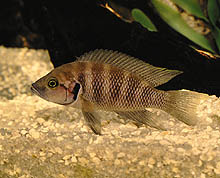
From Burundi, Neolamprologus savoryi has been
received recently. |
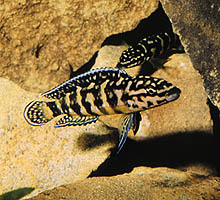
Imported from Zambia, Julidochromis transcriptus
“Gombi” has been re-visited by hobbyists. Photo courtesy of R. Krüter. |
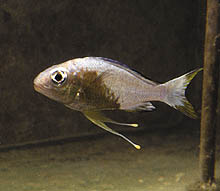
Originally from the Congo coastline, but only available
from bred sources, Ophthalmotilapia ventralis “orange” is a colorful
variety. |
Lake Malawi
Collections and exports from all points around Lake Malawi have slowed
somewhat. Mozambique collections are still off line. Availability
of bred Malawi cichlids is still strong, and the selection of bred varieties
are at an all time high. Recent increases in demand include small,
colorful bread-and-butter varieties of mbuna.

From near Lundu Point in Tanzania, an unknown variety
of Lethrinops looks superficially like L. micrentodon. |

Another newcomer from north of Lupingu (Tanzania)
looks somewhat like a fish sold previously as Labeotropheus trewavasae
“mango”. |

Large bred specimens of Copadichromis virginalis
“Chingata” are popular buys. |
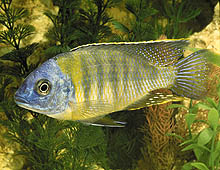
Somewhat larger and found sympatrically with the classic
blue-gold “steveni” in northern Tanzania, Protomelas ‘imperial steveni’
in full breeding dress is deservedly admired by aficionados. |

Collected off Likoma Island, Melanochromis cyaneorhabdos
or “Maingano” is now being exported again. |
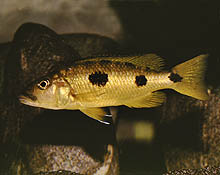
Rarely found in the lake, the yellow variety of Exochromis
anagenys is now available as fry from breeders. |
Victoria
Activity around the Victorian basin seems is virtually nil. As
research activity wanes in Uganda, interest in commercial exports is coming
around. Victorian fans have more to hope for but still must wait
patiently to see what develops.

Does anyone still have stocks of this fish originally
sold as ‘Haplochromis’ sp. “emerald fire”? It hails from Lake
George which is now off-limits due to rebel activity. |
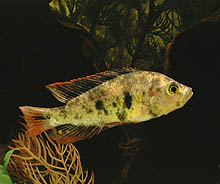 Originally caught below the Owens Dam near Jinga (Uganda) and now available
from breeders, this “Haplochromis” sp. “red-fin piebald” is
a male; females can be red-orange in body coloration.
Originally caught below the Owens Dam near Jinga (Uganda) and now available
from breeders, this “Haplochromis” sp. “red-fin piebald” is
a male; females can be red-orange in body coloration. |
West Africa and Madagascar
Exporters in Guinea and Nigeria are active now. Congo exporters
are hampered somewhat by a shortage of flights to Europe brought on by
safety concerns. Madagascar fans must rely on bred sources for most
items.
|
what's new: West Africa
/ Madagascar
|

Often arriving in shipments from Kinshasa, these riverine
Lamprologus are often contaminants in bags of Steatocranus. |
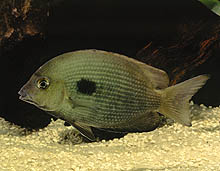 Available in limited quantities from breeders, stocks of Paretroplus
maculatus are now threatened by sensitivity to cold weather in Florida.
Available in limited quantities from breeders, stocks of Paretroplus
maculatus are now threatened by sensitivity to cold weather in Florida. |
Neotropics
Neotropical supplies remain status quo. Recently, shortages in
space on cargo flights from Manaus have affected some Brazil fish importers.
The usual fares from breeders and import items are popular.
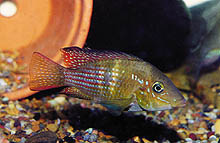
Originally from southern Brazil, Gymnogeophagus
meridionalis is available from specialty breeders. Photo by J.
Rapps. |
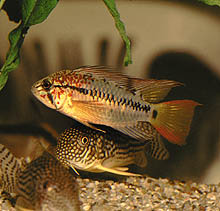
Several dwarf cichlids, like this Apistogramma
viejita “red,” are frequently offered from European breeders. |
|











 Originally caught below the Owens Dam near Jinga (Uganda) and now available
from breeders, this “Haplochromis” sp. “red-fin piebald” is
a male; females can be red-orange in body coloration.
Originally caught below the Owens Dam near Jinga (Uganda) and now available
from breeders, this “Haplochromis” sp. “red-fin piebald” is
a male; females can be red-orange in body coloration.
 Available in limited quantities from breeders, stocks of Paretroplus
maculatus are now threatened by sensitivity to cold weather in Florida.
Available in limited quantities from breeders, stocks of Paretroplus
maculatus are now threatened by sensitivity to cold weather in Florida.
